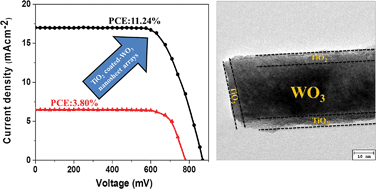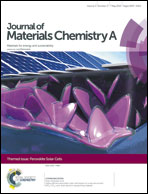Highly efficient perovskite solar cells based on a nanostructured WO3–TiO2 core–shell electron transporting material†
Abstract
Until recently, only mesoporous TiO2 and ZnO were successfully demonstrated as electron transport layers (ETL) alongside the reports of ZrO2 and Al2O3 as scaffold materials in organometal halide perovskite solar cells, largely owing to ease of processing and to high power conversion efficiency. In this article, we explore tungsten trioxide (WO3)-based nanostructured and porous ETL materials directly grown hydrothermally with different morphologies such as nanoparticles, nanorods and nanosheet arrays. The nanostructure morphology strongly influences the photocurrent and efficiency in organometal halide perovskite solar cells. We find that the perovskite solar cells based on WO3 nanosheet arrays yield significantly enhanced photovoltaic performance as compared to nanoparticles and nanorod arrays due to good perovskite absorber infiltration in the porous scaffold and more rapid carrier transport. We further demonstrate that treating the WO3 nanostructures with an aqueous solution of TiCl4 reduces charge recombination at the perovskite/WO3 interface, resulting in the highest power conversion efficiency of 11.24% for devices based on WO3 nanosheet arrays. The successful demonstration of alternative ETL materials and nanostructures based on WO3 will open up new opportunities in the development of highly efficient perovskite solar cells.

- This article is part of the themed collection: Perovskite Solar Cells

 Please wait while we load your content...
Please wait while we load your content...